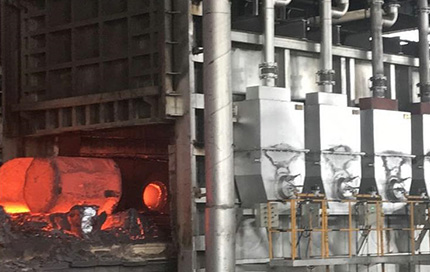Introduction
In the realm of metal processing, precision and efficiency are paramount. Rolling mills, the workhorses of metal production, rely on specialized equipment to achieve their exacting standards. Among these crucial components, the reheating furnace stands out as a linchpin.
This article embarks on a comprehensive journey into the world of reheating furnaces for rolling mills. From its manufacturing process to its applications, features, and advantages, we will dissect this essential piece of equipment.
Additionally, we will shine a spotlight on Yinuo, a leading manufacturer of industrial furnaces, known for their unwavering commitment to excellence and innovation.
What is a Reheating Furnace for Rolling Mill?
1.1 Definition and Purpose
A reheating furnace is a crucial component of a rolling mill process. Its primary function is to raise the temperature of metal ingots or slabs to a range suitable for rolling. By doing so, it ensures the material is malleable, allowing for precise shaping and uniformity in the final product.
1.2 The Manufacturing Process of Reheating Furnaces
1.2.1 Raw Materials
The construction of a reheating furnace begins with the selection of high-quality materials, including refractory bricks, insulation materials, and high-temperature alloys for critical components.
1.2.2 Fabrication and Assembly
The furnace’s structure is fabricated, with a focus on precision and durability. Components such as burners, heating elements, and control systems are carefully integrated.
1.2.3 Quality Assurance
Stringent quality checks are performed at various stages of manufacturing to ensure the furnace meets industry standards for safety, efficiency, and reliability.
Applications and Uses of Reheating Furnaces
2.1 Steel Rolling Mills
In steel rolling mills, reheating furnaces are indispensable. They prepare steel ingots or slabs for the rolling process, ensuring they are at the optimal temperature for shaping and forming.
2.2 Aluminum Rolling Mills
Aluminum rolling mills also heavily rely on reheating furnaces. These furnaces play a crucial role in achieving the required malleability for shaping aluminum sheets and plates.
2.3 Other Metal Processing Industries
Reheating furnaces find applications in various metal processing industries, including copper and brass mills, where they are instrumental in the production of precise and high-quality products.
Features of Modern Reheating Furnaces
3.1 Energy-Efficient Design
Modern reheating furnaces are designed with a focus on energy efficiency, incorporating advanced insulation materials and combustion technologies to minimize heat loss.
3.2 Temperature Control Systems
State-of-the-art temperature control systems allow for precise regulation of the heating process, ensuring that metal reaches the desired temperature range for optimal rolling.
3.3 Automation and Integration
Automation features, including programmable logic controllers (PLCs) and human-machine interfaces (HMIs), streamline operations and enhance the furnace’s integration into the overall rolling mill process.
Advantages of Utilizing Reheating Furnaces
4.1 Enhanced Product Quality
By ensuring uniform temperature distribution, reheating furnaces contribute to higher-quality end products with fewer defects and improved surface finish.
4.2 Increased Production Efficiency
Efficient heating processes result in shorter cycle times, enabling higher production rates and throughput in rolling mill operations.
4.3 Reduction in Scale Formation
Reheating furnaces play a crucial role in scale removal, eliminating surface oxides and contaminants that can compromise the final product’s quality.
Energy Consumption Considerations
5.1 Optimizing Energy Usage
Advanced combustion systems and heat recovery technologies are employed to minimize energy consumption, making modern reheating furnaces more environmentally sustainable.
5.2 Factors Affecting Energy Efficiency
Variables such as furnace design, insulation materials, and control systems significantly impact the energy performance of reheating furnaces.
Precautions and Safety Measures
6.1 Combustion Safety
Proper maintenance of burners and combustion systems is essential to prevent hazards related to fuel ignition and combustion.
6.2 Overheating and Thermal Stress
Monitoring and controlling temperatures within safe limits is crucial to prevent overheating, which can lead to damage or failure of furnace components.
6.3 Emission Control
Adhering to environmental regulations and implementing effective emission control measures is imperative to ensure the furnace’s compliance with industry standards.
Yinuo – Leading the Way in Industrial Furnace Manufacturing
7.1 Company Overview
Yinuo stands as a vanguard in the field of industrial furnace manufacturing. With a rich history of precision engineering and innovation, the company has earned a distinguished reputation for delivering high-quality, reliable furnaces.
7.2 Cutting-Edge Solutions
Yinuo’s furnaces are characterized by their advanced features, energy efficiency, and seamless integration with various industrial processes, making them a preferred choice for discerning manufacturers.
7.3 Commitment to Excellence
Yinuo’s unwavering dedication to customer satisfaction and its ability to provide tailored furnace solutions have solidified its position as a leader in the industry.
Conclusion
The reheating furnace for rolling mills stands as a linchpin in the metal manufacturing process, enabling precision, efficiency, and quality in the production of various metal products. Companies like Yinuo, with their commitment to excellence and innovation, play a pivotal role in advancing the capabilities of reheating furnaces.
As industries continue to evolve, embracing technology and sustainability, reheating furnaces will remain at the forefront of metal production, driving precision, efficiency, and sustainability to new heights.





